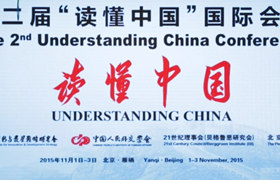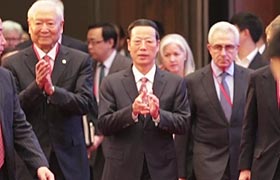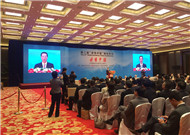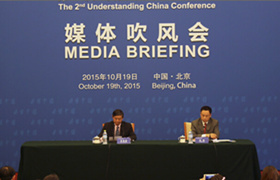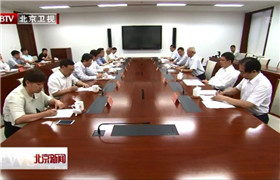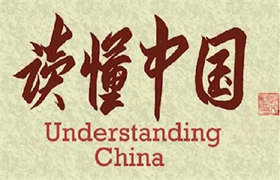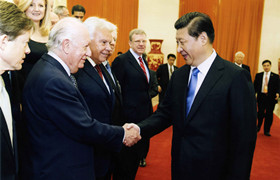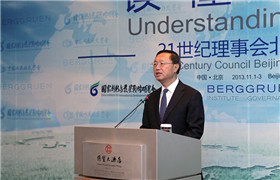- HOME--> Chairman
-
China’s Path of Peaceful Development
Source:
Zheng Bijian
I.
The issue of development path is of fundamental significance. The nation, the people and the party would not have made so many achievements without having embarked on a brand new strategic development path, that is, the road of socialism with Chinese characteristics. As the world is putting more attention to China, debating on whether China’s rapid development is an opportunity or a threat to the rest of the world, especially when the “China threat” and “China collapse” theories are still popular among some groups, the CPC and the Chinese government have solemnly and explicitly declared to the world that China will unswervingly pursue the development path of peaceful rise.
This is the response of China’s new central leadership headed by General Secretary Xi Jinping to the concerns of the international community on China’s development direction after the 18th CPC National Congress. It displays the self-awareness and confidence of the Chinese people to achieve our development goals. And such awareness and confidence come from our understanding of the conditions for development, from our grasp of the development trends in the present world, and from the wealth of the Chinese civilization.
II.
In essence China’s development path addresses the question whether China, a large country with a big population, can turn itself into a “prosperous, democratic, culturally advanced and harmonious modern socialist country” through peaceful development. The answer to this question, or the path of peaceful development, represents a unique road that no other emerging powers in modern history has ever been invented or practiced.
And that is the most notable characteristic of China’s development strategy.
III.
Specifically, there are five basic, inter-related aspects in China’s development path of peaceful rise.
First, it means, in the broadest sense, the path of building socialism with Chinese characteristics through continuous efforts of several or even dozens of generations of the Chinese people; specifically it refers to the fundamental path of peaceful rise in a period which began with the introduction of reform and opening up policies in the late 1970s and will culminate in the completion of the four modernization endeavors and the historical transformation of China from an underdeveloped country to a moderately developed country by the middle of 21st century.
Second, the fundamental goal of this path, for the period of achieving socialist modernization, is to address the problem of people’s right to subsistence, development and education over the 70 years. In other words, we are to concentrate on putting our own house in order and developing our own strength while assuming appropriate international obligations. That will take all the energy and time of several generations of Chinese, making it neither possible nor necessary for China to threat anyone. Even when China becomes a developed country in the future, it will continue on the path of peaceful development steadfastly and “will not change for one hundred years”.
Third, to achieve peaceful development, we need to independently develop socialism with Chinese characteristics by engaging in economic globalization and mutually beneficial cooperation with the international community. By independently I mean that China should mainly rely on itself, on its own institutional and cultural innovations, on industrial restructuring and shift of growth models, and on the improvement of human resource quality and technological progress to overcome the challenges in development.
Fourth, the path of peaceful development requires alignment of internal policies with external policies, and domestic harmony with international peace. In other words, this development path is a guide to both foreign policies and domestic development. It is not only a solemn commitment made to the outside world, but also self-imposed discipline and restraint. However, it is perfectly justifiable that a big country like China should strengthen national defense. Otherwise China would be exposed to substantial risks and this could be a major factor leading to severe turbulence of the entire Asian-Pacific region and even the world at large. Since the Opium War of 1840, the Chinese people, over several generations, have always had a strong sense of crisis, an urge to protect their rights to subsistence and development, and an aspiration to preserve national sovereignty and territory integrity on the one hand, and to strive for development and modernization on the other. We have no desire for military expansion or aggression. In the 1950s, Mao Zedong admonished at the preparatory meeting of the 8th CPC National Congress that China would not deserve a place on the earth if it failed to become a great socialist country. Those words came from his deep-seated commitment to national salvation and rejuvenation. Today, his warnings still hold true if China fails to realize industrialization and modernization in the first half of the 21st century.
Fifth, China’s path of peaceful development, in essence, means the great rejuvenation of the Chinese nation in the first half of the 21st century, by interacting and converging with other contemporary civilizations, engaging in various innovations and through enlightened ideas, sensible ways and methods, and with an respected image. In other words, it means national rejuvenation economically, politically, culturally, socially and ecologically in the process of independent innovation, by adhering to the guidance of Marxism adapted to the contemporary Chinese conditions, by creatively inheriting and building on its fine cultural traditions and by drawing upon all the useful achievements of the civilizations in other parts of the world.
IV.
Furthermore, an overview of the prominent development trends in China and the world since the last two decades of the 20th century suggests that they are all about “great changes and new awakening”, specifically, they are about the “great changes and new awakening of China with peaceful development as the theme” and “great changes and new awakening of the world with peace and development as the theme”. This is a magnificent and unprecedented historical process that came underway in China back at the time of Third Plenary Session of the Eleventh Central Committee of the CPC; worldwide, it was started in the 1970s after the Vietnam War came to an end. Immense new changes have taken place both in China and in the rest of the world over the period of less than 40 years. These changes are destined to continue. A prominent feature here is peaceful rise of a number of developing countries, including China, and further development of the developed countries.
V.
Admittedly, the things in the world are complicated and are the result of many different factors. There are always two sides to any issue. On the one hand, for example, there is peaceful development featuring great changes and new awakening; on the other hand, we have witnessed regional hot wars as a result of lingering Cold War mentality. Development and turbulence are the two sides of one coin. Inevitably, we will continue to witness major changes of the situation evolving in this complicated, two-sided manner.
A notable change in China’s external environment, especially in the Asia-Pacific region, is the “two lines”, one in the north and the other in the south. In the north, China has improved its relations with Russia, with Central Asia countries and with Europe while the Shanghai Cooperation Organization has made headway, although there are still many problems, such as the “three forces” (terrorism, separatism and extremism), that we have to deal with carefully for a prolonged period of time. However, the real difficulty is in the south, caused by the US “return to the Asia-Pacific”, riveting the US-Japan military alliance as the “cornerstone” and seeking to lift the ban on “collective self-defense right”.
But what’s happening in the south also has a positive side, which is the remarkable “Belt and Road” initiative. The silk road over land and sea is about economic, trade, financial, technological and educational cooperation. The initiative has been widely popular among many countries because communities of interests based on the “convergence of interests” have now become a major trend and very likely to be the mainstream in the future. Besides, China and the US may form and develop a “new type of major country relationship”. All these developments are signs of “great changes and new awakening”. History will prove that the “new awakening” will make a big different. “New awakening” will result in wealth, prosperity, development and a promising future of the Asian-Pacific region. In contrast, wanton military alliances and revival of militarism will only lead to a dead end.
These are the “two different prospects for the Asian-Pacific region”.
VI.
In one word, a review of China’s socialist road with Chinese characteristics and the changes in the world and the Asian-Pacific region in the second decade of the 21st century convinces us a bright future is ahead of us. We believe that China, the Asian-Pacific region and the world as a whole will be able to overcome distractions and achieve peaceful development. With peaceful development becoming the center of the future, the truly great progress is yet to come.
The author , Mr. Zheng Bijian is former Executive Vice-President of the Party School of the CPC Central Committee.
The article was published in August 7, 2015 issue of People’s Daily (Page 7).
-
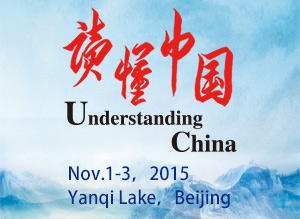
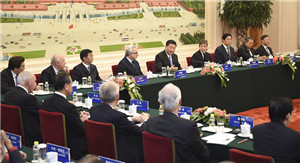
The 2nd "Understanding China" ConferenceOn November 1~3, 2015, the 2nd “Understanding China” Conference was held in Beijing Yanqi Lake International Conference Center. Zhang Gaoli, Vice Premier of the State Council, attended the opening ceremony.
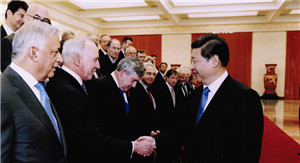
The 1st "Understanding China" ConferenceOn November 1~3, 2013, the 1st “Understanding China” Conference was held in Beijing, which was cosponsored by China Institute for Innovation & Development Strategy (CIIDS), Chinese People’s Institute of Foreign Affairs (CPIFA), and Berggruen Institute on Governance.
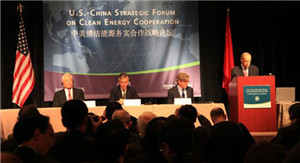
The 2nd U.S.-China Strategic Forum on Clean Energy CooperationWith the “Prospects for U.S.-China strategic cooperation in next decade” as its theme, the forum dwells on the implications of U.S.-China cooperation from the strategic perspective of coping with global challenges and maintaining world peace.
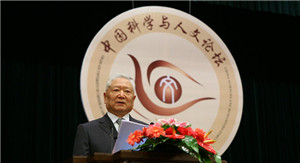
The China Sciences and Humanities ForumCo-initiated in April 2003 by renowned Chinese scientist Mr. Lu Yongxiang and influential political strategist Zhen Bijian, China Sciences and Humanities Forum was jointly hosted by Graduate University of Chinese Academy of Sciences (GUCAS) and the Higher Education Press.

